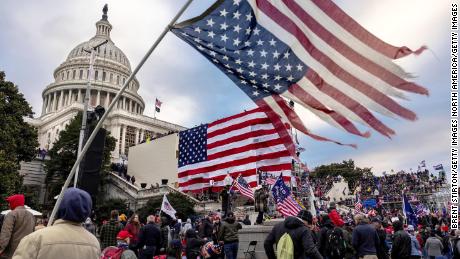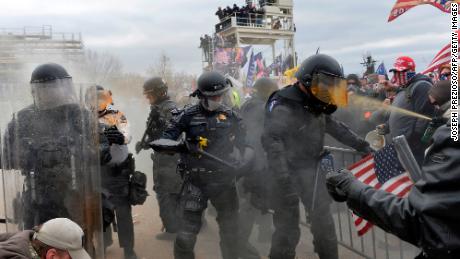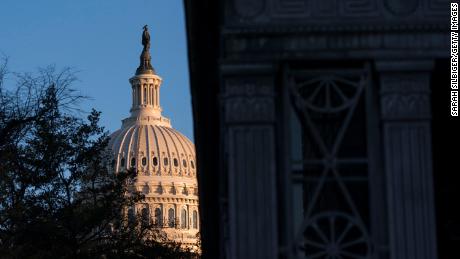Wray knocks down conspiracy theory that rioters were ‘fake Trump protesters’
Testifying publicly for the first time since pro-Trump rioters breached the Capitol nearly two months ago, Wray was pressed by Senate Judiciary Committee Chairman Sen. Dick Durbin on whether the FBI has seen any evidence that individuals involved in the January 6 attack were posing as Trump supporters — a claim the Illinois Democrat called “the next big lie.”
“We have not seen evidence of that, at this stage, certainly,” Wray responded when Durbin asked if he had seen any evidence the riot was organized by “fake Trump protesters,” referring to comments Johnson made during a Senate hearing last week in which he also claimed those involved in the attack were “agents provocateurs.”
Most Republicans on the panel did not embrace these conspiracies, but the baseless claim that left-wing infiltrators were responsible for the violent attack has been promoted by Trump’s impeachment lawyers, several GOP lawmakers and at least one speaker at the Conservative Political Action Conference last week.
On Tuesday, Wray made clear that Antifa and other left-wing groups were not part of the violence on January 6 — even as several Republicans sought to use the hearing as an opportunity to highlight the threat posed by those groups rather than focus on the Capitol attack.
“We have not, to date, seen any evidence of anarchist violent extremists or people subscribing to Antifa in connection to the 6th,” Wray told the Senate committee.
More than 260 defendants — many of them professing allegiance to Trump, disgust for Congress, and supportive of revolution — have been charged in federal court related to their actions in and around the US Capitol siege on January 6.
Previously, nearly a dozen Trump supporters charged in connection with the US Capitol insurrection have said that Antifa and other left-wing groups weren’t involved in the attack, further debunking the conspiracy among Trump supporters.
Wray pressed on ‘Norfolk memo’
While federal law enforcement officials have sought to reassure the American public in the months since the riot that they are up to the task on both fronts, their public remarks also lay bare the enormity of the challenge they face in tracking potential threats to not only the nation’s capital, but across the country.
Law enforcement officials have indicated to CNN that authorities missed key signs ahead of the siege, which left five dead and the Capitol ransacked, and the FBI’s preparations leading up to the day of the attack have come under scrutiny.
On Tuesday, Wray defended the FBI’s sharing of critical information about possible threats to the Capitol ahead of January 6, including its handling of the “Norfolk memo,” which has become central to questions about whether law enforcement agencies protecting the Capitol had enough sound intelligence before the siege to prepare.
Wray described how the FBI shared an intelligence report about online chatter before January 6 quickly, in three ways with other law enforcement agencies, after receiving the information from the FBI’s Norfolk field office.
His answers to at least three senators’ questions on Tuesday about the Norfolk report fill out where and how the intelligence was shared, and stands in contrast to testimony last week from law enforcement chiefs around the Capitol who largely blamed security failures on a lack of intelligence that had been communicated.
The Norfolk report was passed to law enforcement partners, Wray said, including the Capitol Police and metro police within an hour of it being received.
It was shared in three ways: an email to the Joint Terrorism Task Force, a verbal command post briefing in the Washington field office and at FBI headquarters that involved police in DC, and through the law enforcement portal, according to Wray.
“In a perfect world we would have taken longer to figure out whether it was reliable, but we made the judgment, our folks made the judgment to get that information to the relevant people as quickly as possible, like I said, three different ways, in order to leave as little as possible to chance,” Wray said.
Wray called the memo “raw, unverified, uncorroborated information” that had been gathered from online posts, but was notable enough for the FBI to share with police in Washington almost immediately. “It’s more than just an email,” Wray said.
Wray did not see the Norfolk report until after the 6th, he added.
“As to why the information didn’t flow to people in all the departments … I don’t have an answer for that,” he said later.
FBI gaining intelligence through arrests
Charging documents continue to reveal new information about the extremists who took part in the US Capitol attack, including members of right-wing militant groups who prosecutors have charged with conspiracy-related crimes.
Yet lawmakers have indicated they remain less clear on the threat these types of individuals continue to pose and have unsuccessfully pressed law enforcement officials to justify the heightened security posture on Capitol Hill.
A Department of Homeland Security spokesperson told CNN last month that officials are not currently tracking any “credible or specific threats,” but continue to constantly monitor online chatter about potential violence in Washington, DC, and against members of Congress.
Wray said Tuesday the FBI is “always looking to develop more and better sources” to combat domestic terrorism and counterterrorism threats, but the key to gaining intelligence is through arrests.
He also told lawmakers that says the more arrests the FBI makes, “the more from those cases we learn about who else their contacts are, what their tactics are, what their strategies are … and that makes us smarter and better able to get in front of the threat, going forward.”
CNN’s Jeff Zeleny, Whitney Wild, Ali Zaslav and Manu Raju contributed to this report.
![]()








